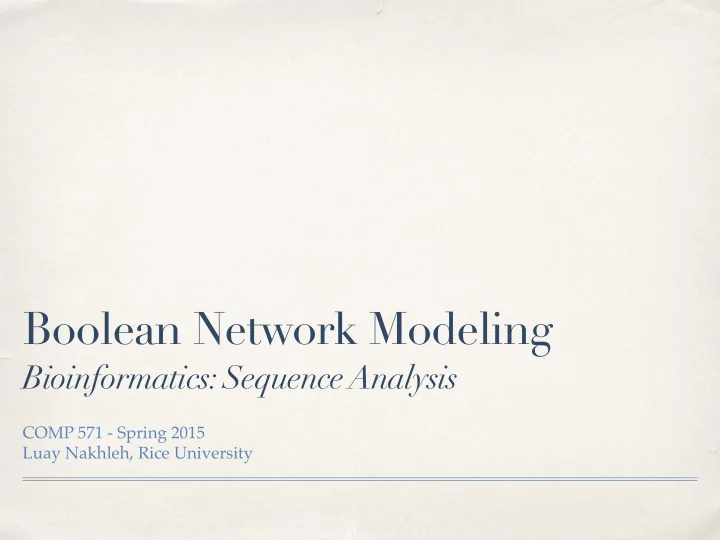

Boolean Network Modeling Bioinformatics: Sequence Analysis COMP 571 - Spring 2015 Luay Nakhleh, Rice University
Gene Regulatory Networks ✤ Gene regulatory networks describe the molecules involved in gene regulation, as well as their interactions. ✤ Transcription factors are stimulated by upstream signaling cascades and bind on cis-regulatory positions of their target genes. ✤ Bound transcription factors promote or inhibit RNA polymerase assembly and thus determine whether and to what extent the target gene is expressed.
Gene Regulatory Networks
Outline ✤ Graph representation ✤ Boolean networks
Graph Representation ✤ A directed graph G=(V,E) is a tuple where V denotes a set of vertices (or nodes) and E a set of edges. ✤ An edge (i,j) in E indicates that i regulates the expression of j. ✤ Edges can have information about interactions. For example, (i,j,+) for “i activates j” and (i,j,-) for “i inhibits j”. ✤ Annotated directed graphs are the most commonly available type of data for regulatory networks.
Graph Representation ✤ Directed graphs do not suffice to describe the dynamics of a network, but they may contain information that allows certain predictions about network properties: ✤ Tracing paths between genes yields sequences of regulatory events, shows redundancy in the regulation, or indicates missing regulatory interactions (that are, for example, known from experiments). ✤ A cycle may indicate feedback regulation. ✤ Comparison of GRNs of different organisms may reveal evolutionary relations and targets for bioengineering and pharmaceutical applications. ✤ The network complexity can be measured by the connectivity.
Graph Representation
Boolean Networks
Boolean Networks ✤ Boolean networks are qualitative descriptions of gene regulatory interactions ✤ Gene expression has two states: on (1) and off (0) ✤ Let x be an n-dimensional binary vector representing the state of a system of n genes ✤ Thus, the state space of the system consists of 2 n possible states
Boolean Networks ✤ Each component, x i , determines the expression of the i th gene ✤ With each gene i we associate a Boolean rule, b i ✤ Given the input variables for gene i at time t, this function determines whether the regulated element is active (1) or inactive (0) at time t+1, i.e., x i ( t + 1) = b i ( x ( t )) , 1 ≤ i ≤ n
Boolean Networks ✤ The practical feasibility of Boolean networks is heavily dependent on the number of input variables, k, for each gene ✤ The number of possible input states of k inputs is 2 k ✤ For each such combination, a specific Boolean function must determine whether the next state would be on or off ✤ Thus, there are 2 2k possible Boolean functions (or rules) ✤ This number rapidly increases with the connectivity
Boolean Networks ✤ In a Boolean network each state has a deterministic output state ✤ A series of states is called a trajectory ✤ If no difference occurs between the transitions of two states, i.e., output state equals input state, then the system is in a point attractor ✤ Point attractors are analogous to steady states ✤ If the system is in a cycle of states, then we have a dynamic attractor
Boolean Networks ✤ Since the number of states in the state space is finite, the number of possible transitions is also finite. ✤ Therefore, each trajectory will lead either to a steady state or to a state cycle. These state sequences are called attractors . ✤ Transient states are those states that do not belong to an attractor. ✤ All states that lead to the same attractor constitute its basin of attraction .
Boolean Networks
Boolean Networks ✤ The temporal behavior is determined by the sequence of states (a,b,c,d) given in an initial state. ✤ What happens if the initial state of a is 0? If the initial state of a is 1?
Boolean Networks
Boolean Networks: The REVEAL Algorithm “REVEAL, A general reverse engineering algorithm for inference of genetic network architectures” Liang et al., PSB 1998
Recommend
More recommend